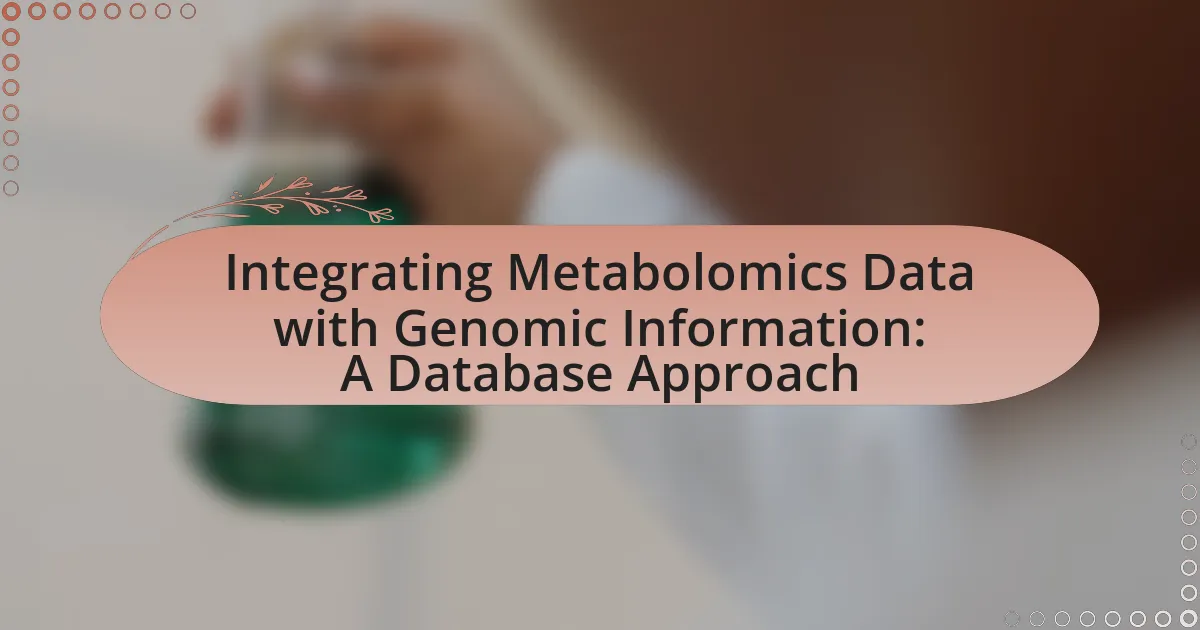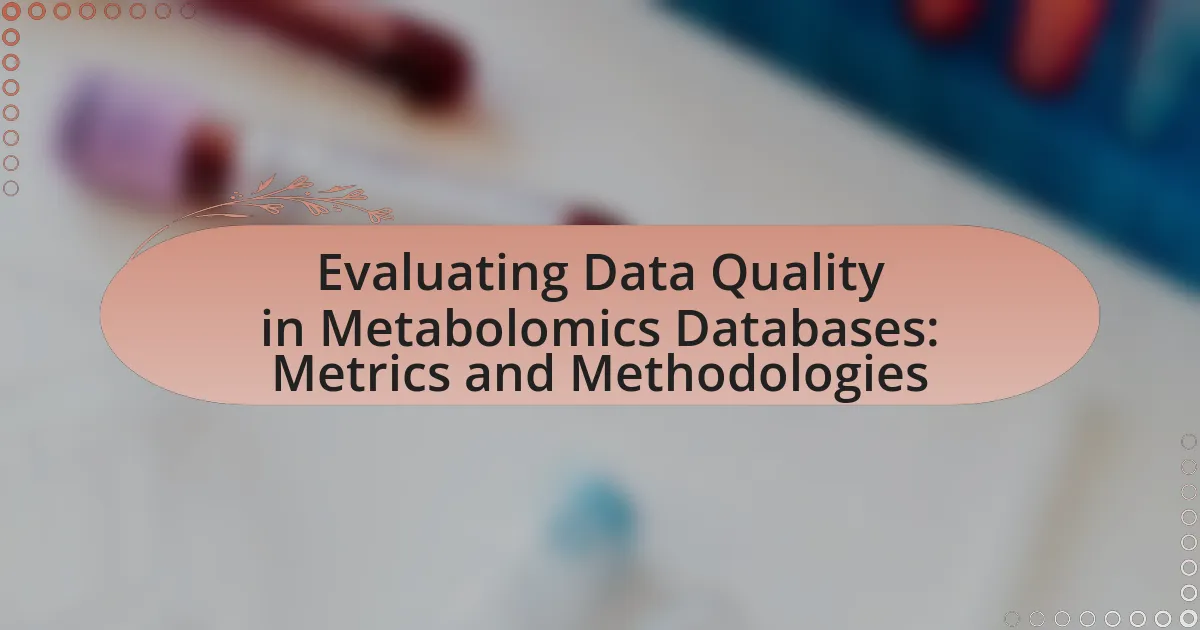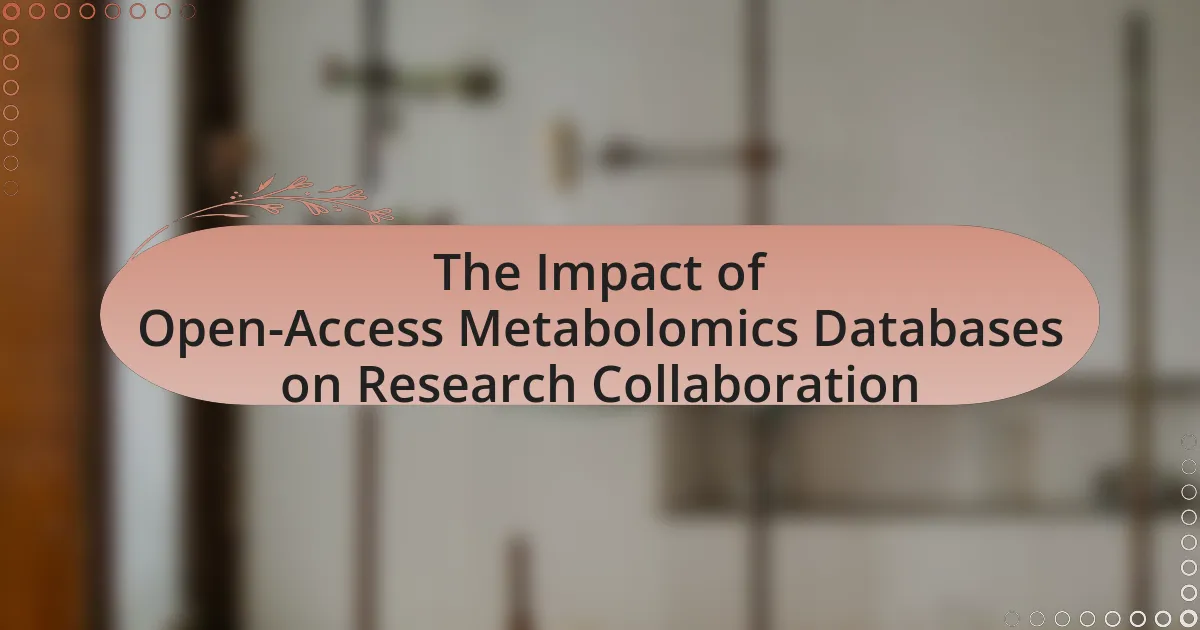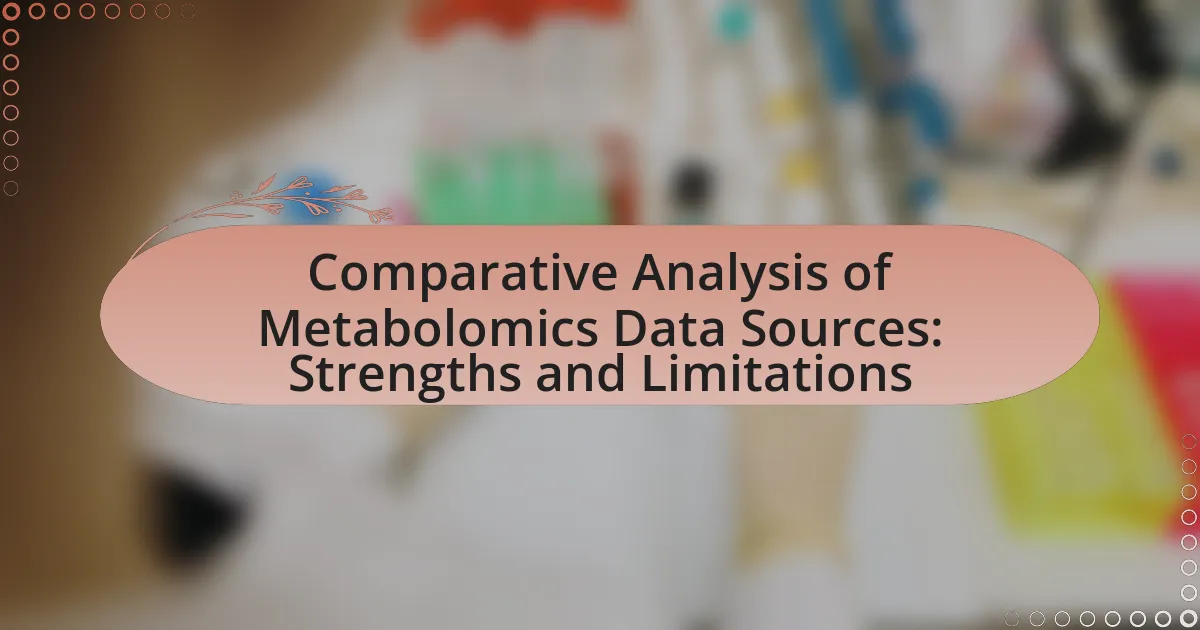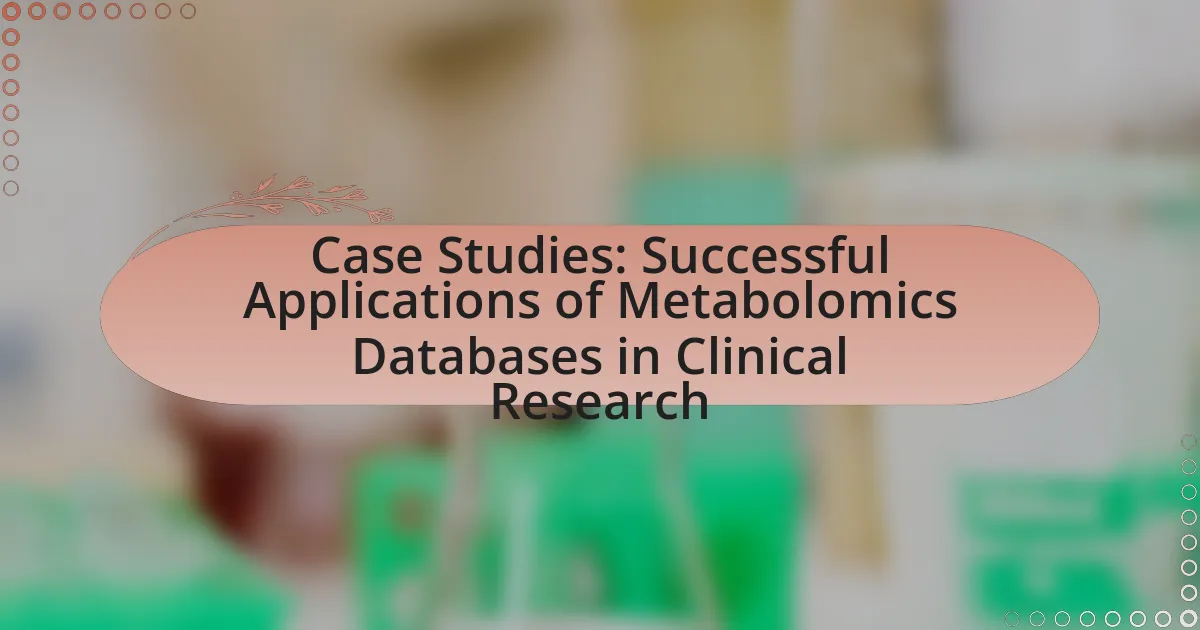Integrating metabolomics data with genomic information is a critical approach in biological research that enhances the understanding of complex biological processes and disease mechanisms. This article explores the interaction between metabolomics and genomics, highlighting their differences, the importance of data integration for scientific discovery, and the challenges faced in this integration. It discusses methodologies for combining these data types, the role of bioinformatics tools, and the significance of database approaches in facilitating integration. Additionally, the article addresses best practices for database design, data quality assurance, and future directions in the field, emphasizing the potential breakthroughs that improved integration techniques could yield in personalized medicine.
What is Integrating Metabolomics Data with Genomic Information?
Integrating metabolomics data with genomic information involves combining metabolic profiles with genetic data to enhance understanding of biological processes and disease mechanisms. This integration allows researchers to identify correlations between metabolic changes and genetic variations, facilitating insights into how genes influence metabolism and contribute to health or disease states. Studies have shown that such integrative approaches can lead to improved biomarker discovery and personalized medicine strategies, as evidenced by research published in journals like Nature Reviews Genetics, which highlights the significance of multi-omics data in elucidating complex biological interactions.
How do metabolomics and genomics interact in biological research?
Metabolomics and genomics interact in biological research by providing complementary insights into biological systems, where genomics identifies genetic variations and metabolomics measures the resultant metabolic changes. This interaction allows researchers to understand how genetic information translates into metabolic phenotypes, facilitating the identification of biomarkers for diseases and the development of personalized medicine. For instance, studies have shown that specific genetic variants can influence metabolic pathways, leading to variations in metabolite levels, which can be quantified through metabolomic profiling. This integrative approach enhances the understanding of complex biological processes and disease mechanisms, as evidenced by research demonstrating that combining genomic and metabolomic data improves the predictive power for disease outcomes.
What are the key differences between metabolomics and genomics?
Metabolomics and genomics differ primarily in their focus; metabolomics studies the complete set of metabolites in a biological sample, while genomics examines the complete set of genes and their functions. Metabolomics provides insights into the biochemical processes and metabolic pathways active in an organism at a specific time, reflecting the organism’s physiological state. In contrast, genomics offers information about the genetic blueprint and potential traits of an organism, which may not always correlate with its current metabolic state. This distinction is crucial for understanding biological systems, as metabolomics can reveal dynamic changes in response to environmental factors, whereas genomics provides a static view of genetic potential.
Why is integration of these data types important for scientific discovery?
Integration of metabolomics data with genomic information is crucial for scientific discovery because it enables a comprehensive understanding of biological systems. This integration allows researchers to correlate metabolic profiles with genetic variations, facilitating insights into disease mechanisms and potential therapeutic targets. For instance, studies have shown that integrating these data types can enhance biomarker discovery, as demonstrated in research published in “Nature Biotechnology,” where the combined analysis led to the identification of novel metabolic pathways associated with cancer. Such integrative approaches ultimately drive advancements in personalized medicine and improve the efficacy of treatments.
What are the main challenges in integrating metabolomics and genomic data?
The main challenges in integrating metabolomics and genomic data include data heterogeneity, complexity of biological systems, and the need for advanced computational tools. Data heterogeneity arises from the different types of data generated by metabolomics and genomics, which often require distinct analytical methods and standards. The complexity of biological systems complicates the interpretation of how metabolic pathways interact with genetic information, making it difficult to establish clear correlations. Additionally, the integration process demands advanced computational tools capable of handling large datasets and performing sophisticated analyses, which are often not readily available or require significant expertise to utilize effectively.
How do data variability and complexity affect integration efforts?
Data variability and complexity significantly hinder integration efforts by introducing inconsistencies and challenges in data harmonization. Variability in data types, formats, and sources can lead to difficulties in aligning datasets, while complexity, such as the presence of numerous variables and relationships, complicates the integration process. For instance, in metabolomics, diverse metabolite profiles across different biological samples can result in heterogeneous data that is difficult to standardize. This variability necessitates advanced computational methods for effective integration, as highlighted in studies like “Integrating Metabolomics and Genomics Data: A Review” by Zhang et al., which emphasizes the need for robust algorithms to manage such complexities.
What technological limitations exist in current integration methods?
Current integration methods for metabolomics and genomic data face several technological limitations, including data heterogeneity, scalability issues, and lack of standardized protocols. Data heterogeneity arises from the diverse formats and types of data generated by different platforms, making it challenging to achieve seamless integration. Scalability issues occur as the volume of data increases, often leading to performance bottlenecks in data processing and analysis. Additionally, the absence of standardized protocols hampers reproducibility and comparability across studies, which is critical for validating findings. These limitations hinder the effective integration of metabolomics and genomic information, impacting the overall utility of the data in research and clinical applications.
What methodologies are used for integrating metabolomics and genomic data?
Methodologies for integrating metabolomics and genomic data include multi-omics approaches, data fusion techniques, and network-based integration. Multi-omics approaches combine data from various omics layers, such as genomics, transcriptomics, and metabolomics, to provide a comprehensive view of biological systems. Data fusion techniques utilize statistical methods and machine learning algorithms to merge datasets, enhancing the interpretation of complex biological interactions. Network-based integration employs biological networks to visualize and analyze the relationships between metabolites and genes, facilitating the identification of key regulatory pathways. These methodologies are supported by advancements in computational tools and databases that enable efficient data integration and analysis.
How do database approaches facilitate data integration?
Database approaches facilitate data integration by providing structured frameworks that enable the seamless combination of diverse data sources. These frameworks utilize standardized data models and schemas, which allow for consistent data representation across different systems. For instance, relational databases employ tables with defined relationships, making it easier to merge metabolomics data with genomic information. This structured organization enhances data accessibility and interoperability, allowing researchers to query and analyze integrated datasets efficiently. Furthermore, database management systems often include tools for data transformation and cleaning, which are essential for ensuring data quality and compatibility during integration processes.
What role do bioinformatics tools play in this integration?
Bioinformatics tools are essential for integrating metabolomics data with genomic information as they facilitate data analysis, visualization, and interpretation. These tools enable researchers to manage large datasets, perform complex statistical analyses, and identify correlations between metabolic profiles and genetic variations. For instance, software like MetaboAnalyst allows for the integration of metabolomic and genomic data, providing insights into metabolic pathways influenced by genetic factors. This integration is crucial for understanding biological processes and disease mechanisms, as evidenced by studies that demonstrate how bioinformatics approaches can reveal significant associations between metabolites and gene expression patterns.
How can a database approach enhance the integration of metabolomics and genomic data?
A database approach enhances the integration of metabolomics and genomic data by providing a structured framework for storing, managing, and analyzing complex biological information. This structured framework allows for the efficient correlation of metabolic profiles with genomic sequences, facilitating the identification of biomarkers and understanding of metabolic pathways. For instance, databases like MetaboLights and KEGG integrate metabolomic data with genomic annotations, enabling researchers to explore relationships between metabolites and genes systematically. Such integration supports hypothesis generation and testing in systems biology, ultimately leading to more comprehensive insights into biological processes and disease mechanisms.
What are the key features of an effective database for this integration?
An effective database for integrating metabolomics data with genomic information must possess robust data storage capabilities, efficient querying mechanisms, and seamless interoperability. These features ensure that large volumes of complex data can be stored, accessed, and analyzed efficiently. For instance, a relational database management system (RDBMS) can handle structured data effectively, while NoSQL databases may be utilized for unstructured data, allowing for flexibility in data types. Additionally, the database should support advanced analytics and visualization tools to facilitate data interpretation. Interoperability with existing bioinformatics tools and standards, such as the use of APIs and adherence to data formats like JSON or XML, enhances the database’s usability across different platforms. These features collectively enable researchers to derive meaningful insights from the integration of metabolomics and genomic data, ultimately advancing the field of systems biology.
How does data standardization improve integration outcomes?
Data standardization improves integration outcomes by ensuring consistency and compatibility across diverse datasets. When metabolomics data is standardized, it allows for seamless merging with genomic information, facilitating accurate analysis and interpretation. For instance, standardized formats reduce discrepancies in data representation, which can lead to erroneous conclusions. Studies have shown that standardized data practices enhance the reliability of integrative analyses, ultimately leading to more robust biological insights and discoveries.
What types of data visualization tools are beneficial in this context?
Data visualization tools beneficial for integrating metabolomics data with genomic information include heatmaps, scatter plots, and network diagrams. Heatmaps effectively display large datasets, allowing for the visualization of correlations between metabolites and genes. Scatter plots facilitate the identification of relationships and trends between two variables, such as metabolite levels and gene expression. Network diagrams illustrate complex interactions between metabolites and genes, providing insights into biological pathways. These tools enhance data interpretation and support the analysis of intricate biological relationships in metabolomics and genomics.
What are the best practices for designing a database for metabolomics and genomic data?
The best practices for designing a database for metabolomics and genomic data include ensuring data interoperability, implementing robust data models, and maintaining comprehensive metadata documentation. Data interoperability allows for seamless integration of diverse datasets, which is crucial in metabolomics and genomics where data originates from various platforms and technologies. A robust data model, such as using relational databases or NoSQL systems, supports complex queries and efficient data retrieval, accommodating the large volumes of data typical in these fields. Comprehensive metadata documentation is essential for data provenance, enabling researchers to understand the context and conditions under which data was collected, thus enhancing reproducibility and data sharing. These practices are supported by studies that emphasize the importance of structured data management in bioinformatics, such as the work by Karp et al. (2019) in “Bioinformatics” which highlights the need for standardized data formats and metadata in biological databases.
How can user accessibility be ensured in database design?
User accessibility in database design can be ensured by implementing user-friendly interfaces and adhering to accessibility standards such as WCAG (Web Content Accessibility Guidelines). User-friendly interfaces facilitate easy navigation and interaction, while compliance with WCAG ensures that the database is usable by individuals with disabilities, including those who rely on assistive technologies. For instance, using clear labeling, keyboard navigation, and screen reader compatibility enhances accessibility. Studies show that databases designed with these principles can significantly improve user engagement and satisfaction, as evidenced by increased usage metrics in accessible systems compared to those lacking such features.
What security measures should be implemented to protect sensitive data?
To protect sensitive data, organizations should implement encryption, access controls, and regular security audits. Encryption ensures that data is unreadable to unauthorized users, safeguarding it during storage and transmission. Access controls limit data access to authorized personnel only, reducing the risk of data breaches. Regular security audits help identify vulnerabilities and ensure compliance with data protection regulations, such as GDPR, which mandates strict data handling practices. These measures collectively enhance the security posture of organizations handling sensitive data.
What are the future directions for integrating metabolomics and genomic data?
Future directions for integrating metabolomics and genomic data include the development of comprehensive databases that combine multi-omics data, enhancing predictive modeling for personalized medicine. Advances in computational tools and machine learning algorithms will facilitate the integration of large-scale datasets, allowing for better identification of biomarkers and understanding of metabolic pathways. Collaborative efforts among researchers, clinicians, and bioinformaticians will be essential to standardize data formats and improve data sharing practices, ultimately leading to more effective therapeutic strategies and disease management.
How is artificial intelligence shaping the future of data integration?
Artificial intelligence is transforming the future of data integration by enabling automated data processing, enhancing data quality, and facilitating real-time analytics. AI algorithms can analyze vast datasets from diverse sources, such as metabolomics and genomic information, to identify patterns and correlations that would be difficult for humans to discern. For instance, machine learning techniques can improve data harmonization and reduce inconsistencies, leading to more reliable integration outcomes. Additionally, AI-driven tools can streamline workflows, allowing researchers to focus on interpretation rather than data management, thereby accelerating discoveries in fields like personalized medicine.
What potential breakthroughs could arise from improved integration techniques?
Improved integration techniques could lead to significant breakthroughs in personalized medicine, enabling more accurate disease diagnosis and treatment strategies. By effectively combining metabolomics data with genomic information, researchers can identify specific metabolic pathways associated with genetic variations, enhancing the understanding of disease mechanisms. For instance, studies have shown that integrating these data types can reveal biomarkers for conditions like cancer and diabetes, allowing for targeted therapies tailored to individual patient profiles. This integration can also facilitate the discovery of novel therapeutic targets, ultimately improving patient outcomes and advancing precision health initiatives.
What practical tips can researchers follow when integrating these data types?
Researchers should ensure data standardization when integrating metabolomics data with genomic information. Standardization facilitates compatibility between different data types, allowing for accurate comparisons and analyses. Utilizing established protocols, such as the Metabolomics Standards Initiative (MSI) guidelines, can enhance data quality and interoperability. Additionally, employing robust database management systems that support both metabolomic and genomic data types can streamline integration processes. For instance, using platforms like MetaboAnalyst or KEGG can provide tools for data visualization and analysis, improving the overall research outcomes.
How can researchers ensure data quality during integration?
Researchers can ensure data quality during integration by implementing standardized protocols for data collection and processing. Standardization minimizes variability and enhances comparability across datasets, which is crucial when integrating metabolomics data with genomic information. Additionally, employing data validation techniques, such as cross-referencing with established databases and using automated quality control checks, helps identify and rectify errors early in the integration process. Studies have shown that adherence to these practices significantly improves the reliability of integrated datasets, as evidenced by the successful integration of diverse omics data in projects like The Cancer Genome Atlas, which utilized rigorous data quality assessments to ensure high-quality outputs.
What resources are available for researchers looking to enhance their integration efforts?
Researchers looking to enhance their integration efforts can utilize several key resources, including databases, software tools, and collaborative platforms. Notable databases such as MetaboLights and the Human Metabolome Database provide comprehensive metabolomics data that can be integrated with genomic information. Software tools like Galaxy and Cytoscape facilitate data analysis and visualization, enabling researchers to explore complex relationships between metabolites and genes. Additionally, collaborative platforms such as the Metabolomics Society and various online forums foster knowledge sharing and networking among researchers, which can lead to improved integration strategies. These resources collectively support the integration of metabolomics and genomic data, enhancing research outcomes in this field.
